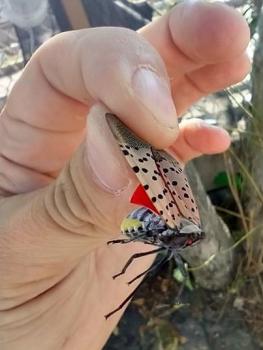The MA Department of Agricultural Resources (MDAR) announced on 9/28/21 that a small, established, and breeding population of the invasive spotted lanternfly (Lycorma delicatula) was detected in Worcester County, in the city of Fitchburg. This finding was confirmed by state officials.
For further details regarding what is currently known about this population in Fitchburg and MDAR’s response, read MDAR’s press release.
What Should You Do?
Residents and professionals living and working across the Commonwealth should learn the life stages of the spotted lanternfly and be able to identify their eggs, immatures, and adults. At this time, it is particularly valuable to learn how to ID spotted lanternfly adults and egg masses.
If you think you have found any of the life stages of this insect in Massachusetts, report them immediately here.
In particular, if you know of tree of heaven (Ailanthus altissima)* growing nearby, check that preferred host for adults and egg masses and report anything suspicious using the link above. That said, spotted lanternfly adults and eggs masses (and immatures when active) may be found just about anywhere.
*The tree of heaven is a rapidly growing deciduous tree native to China and Taiwan that has become a widespread invasive species across North America. Learn how to identify this invasive tree here: https://extension.psu.edu/tree-of-heaven.
Should You Treat?
At this time, the only established (breeding) population of spotted lanternfly in Massachusetts is in a small area of Fitchburg, MA. Therefore, there is no reason to preemptively treat for this insect in other areas of Massachusetts at this time. If you suspect you have found spotted lanternfly in additional locations, please report it immediately to MDAR at the link above. If you are living and working in the Fitchburg area, please be vigilant and continue to report anything suspicious.
What is at Risk?
The spotted lanternfly feeds on over 103 different species of plants, including agriculturally significant crops (apple, peach, grape, etc.) and trees and shrubs that are important in our managed landscapes and natural areas. Due to various factors, spotted lanternflies are also a significant public nuisance once they become established.
For More Information
- UMass Extension: Spotted Lanternfly fact sheet
- MDAR's Spotted lanternfly fact sheet
- Nursery Best Management Practices (January 2021)
- Best Practices for Businesses
- Checklist for Residents in or near Infested Areas
- Driver’s Checklist in English or Spanish (September 2021)
- Moving Industry Checklist
